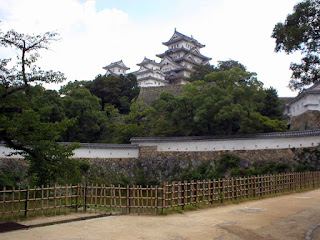
Japanese Castles
Japan was first united under a single ruler almost two thousand years ago, and the first recorded ruler was a woman, Himiko. That information, however, comes from Chinese travelers to Japan in the second or third century. Japanese history traditionally begins with the first emperor, Jimmu, a descendant of the sun goddess, Amaterasu. Be that as it may, Japan has had the same royal family for over 1500 years. Rarely have they held real power--through most of Japan's history they have been accorded great respect, but various warlords have fought over the real political power.
The most famous warriors were the samurai--the military class who were hired as mercenaries when the Fujiwara government collapsed in the eleventh century--and the shoguns, who became powerful in the 14th century.

I must admit to not being as familiar with Japanese history as I might be, so even as I enjoyed the beauty of the castles we visited I did not have people and events in my head to connect them to as I do when I visit castles in Europe. The castle you see here is Himeji, generally considered to be the most beautiful castle in Japan.

Castles, as opposed to palaces, are fortresses whose primary function is defense. Some castles house leaders' families, while others are simply garrisons for soldiers. In Europe, castles are combinations of purely utilitarian defensive areas, design unaffected by esthetics, and areas designed to house and delight the families of the rulers who live there. In Japan, no part of a castle is utilitarian ugly--all parts are beautiful and esthetically balanced.
As you see here, Japanese castles have in common with European castles that they are usually built on hilltops, for defense purposes. One of the things we learned about Japanese castles is that the architecture on the inside does not match the architecture on the outside: the exterior hides the fact that there is one more story on the inside than is evident from the outside, masking whichever floor housed the family.
Another difference between European and Japanese castles is that Japanese castles are completely finished on the inside, with wooden floors and paneling. European castles tend to be mostly bare stone, with rooms for family hung with tapestries to lend color and cut the cold. Narrow stone spiral staircases are found in the walls, difficult to climb but easy to defend. Japanese castles have wooden staircases inside the rooms--but some of them are on ropes, so they can be hauled up from above. Different methods to achieve the same purpose of defense against intruders.
__________________________________
Learn to Speak Japanese
How to import a car from Japan. Click here.
Click here for Seven Reasons to Visit India.
This series of posts on my trip to Japan begins here.
The journal of my trip to India and Nepal begins here.
The series of posts on my trip to Italy begins here.
Geezer-Chick's guest blog on York, England is here.
MATERIAL CONNECTION DISCLOSURE: You should assume that the author of this blog has an affiliate relationship and/or another material connection to the providers of goods and services mentioned in this message and may be compensated when you purchase from a provider. You should always perform due diligence before buying goods or services from anyone via the Internet or offline.




No comments:
Post a Comment